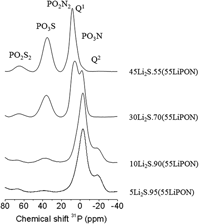Crossref Citations
This article has been cited by the following publications. This list is generated based on data provided by
Crossref.
Michel, Fabian
Kuhl, Florian
Becker, Martin
Janek, Juergen
and
Polity, Angelika
2019.
Electrochemical and Optical Properties of Lithium Ion Conducting LiPSON Solid Electrolyte Films.
physica status solidi (b),
Vol. 256,
Issue. 10,
Kmiec, Steven
and
Martin, Steve W.
2021.
Synthesis, Short-Range Order Structure, and Thermal Properties of Mixed Oxy-sulfide Nitride (MOSN) Glasses.
Inorganic Chemistry,
Vol. 60,
Issue. 18,
p.
13968.
Lupo, Christian
Michel, Fabian
Kuhl, Florian
Su, Yurong
Becker, Martin
Polity, Angelika
and
Schlettwein, Derck
2021.
Investigation of Sputter‐Deposited Thin Films of Lithium Phosphorous Sulfuric Oxynitride (LiPSON) as Solid Electrolyte for Electrochromic Devices.
physica status solidi (b),
Vol. 258,
Issue. 10,
Muñoz, Francisco
2022.
The chemistry of melting oxynitride phosphate glasses.
Pure and Applied Chemistry,
Vol. 94,
Issue. 2,
p.
189.
Dai, Wangqi
Qiao, Yan
Ma, Ziqiang
Wang, Tian
and
Fu, Zhengwen
2022.
All-solid-state thin-film batteries based on lithium phosphorus oxynitrides.
Materials Futures,
Vol. 1,
Issue. 3,
p.
032101.
Schneider, Stefanie
Kreiner, Sandra T.
Balzat, Lucas G.
Lotsch, Bettina V.
and
Schnick, Wolfgang
2023.
Finding Order in Disorder: The Highly Disordered Lithium Oxonitridophosphate Double Salt Li8+xP3O10−xN1+x (x=1.4(5)).
Chemistry – A European Journal,
Vol. 29,
Issue. 55,
Torres, Victor M.
Kalnaus, Sergiy
Martin, Steve W.
Duggan, Caitlin
and
Westover, Andrew S.
2023.
Structure‐mechanical properties correlation in bulk LiPON glass produced by nitridation of metaphosphate melts.
Journal of the American Ceramic Society,
Vol. 106,
Issue. 11,
p.
6565.
Duval, Alexis
Houizot, Patrick
and
Rouxel, Tanguy
2023.
Review: Elaboration, structure, and mechanical properties of oxynitride glasses.
Journal of the American Ceramic Society,
Vol. 106,
Issue. 3,
p.
1611.
Zimmermanns, Ramon
Luo, Xianlin
Hansen, Anna-Lena
Sadowski, Marcel
Fu, Qiang
Albe, Karsten
Indris, Sylvio
Knapp, Michael
and
Ehrenberg, Helmut
2024.
Influence of oxygen distribution on the Li-ion conductivity in oxy-sulfide glasses – taking a closer look.
Dalton Transactions,
Vol. 53,
Issue. 32,
p.
13348.
